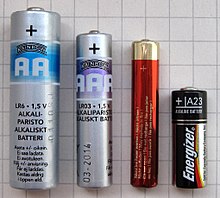This article needs additional citations for verification. (February 2018) |
| Voltage | |
|---|---|
 Batteries are sources of voltage in many electric circuits. | |
Common symbols | V , ∆V , U , ∆U |
| SI unit | volt |
| In SI base units | kg⋅m2⋅s−3⋅A−1 |
Derivations from other quantities | Voltage = Energy / charge |
| Dimension | |
| Articles about |
| Electromagnetism |
|---|
 |
Voltage, also known as (electrical) potential difference, electric pressure, or electric tension is the difference in electric potential between two points.[1][2] In a static electric field, it corresponds to the work needed per unit of charge to move a positive test charge from the first point to the second point. In the International System of Units (SI), the derived unit for voltage is the volt (V). [3][4][5]
The voltage between points can be caused by the build-up of electric charge (e.g., a capacitor), and from an electromotive force (e.g., electromagnetic induction in a generator).[6][7] On a macroscopic scale, a potential difference can be caused by electrochemical processes (e.g., cells and batteries), the pressure-induced piezoelectric effect, and the thermoelectric effect. Since it is the difference in electric potential, it is a physical scalar quantity.[8]
A voltmeter can be used to measure the voltage between two points in a system.[9] Often a common reference potential such as the ground of the system is used as one of the points. In this case, voltage is often mentioned at a point without completely mentioning the other measurement point. A voltage can be associated with either a source of energy or the loss, dissipation, or storage of energy.
- ^ Cretì, Anna; Fontini, Fulvio (2019-05-30). Economics of Electricity: Markets, Competition and Rules. Cambridge University Press. p. 18. ISBN 978-1-107-18565-4.
- ^ Tregub, Stanislav (2020-08-08). Theory of Energy Harmony: Mechanism of Fundamental Interactions. Stanislav Tregub. p. 26. ISBN 978-5-6044739-2-4.
- ^ David B. Newell, Eite Tiesinga (August 2019). The International System of Units (SI) (PDF) (Report). National Institute of Standards and Technology. p. 31. Retrieved 2 January 2024.
- ^ Holloway, Michael D.; Holloway, Emma (2020-12-09). Dictionary of Industrial Terminology. John Wiley & Sons. p. 1259. ISBN 978-1-119-36410-8.
- ^ Aslam, Dr S.; Sharma, Dr Pradosh Kumar; Rahul, Satyakam; Saluja, Dr Hitanshu (2024-01-26). Integrating Electrical Systems With Intelligent Computing. Academic Guru Publishing House. p. 17. ISBN 978-81-19843-91-6.
- ^ Demetrius T. Paris and F. Kenneth Hurd, Basic Electromagnetic Theory, McGraw-Hill, New York 1969, ISBN 0-07-048470-8, pp. 512, 546
- ^ P. Hammond, Electromagnetism for Engineers, p. 135, Pergamon Press 1969 OCLC 854336.
- ^ Experts, Disha (2017-08-29). 10 in One Study Package for CBSE Physics Class 12 with 5 Model Papers. Disha Publications. p. 64. ISBN 978-93-86323-72-9.
- ^ International, Petrogav. Production Course for Hiring on Offshore Oil and Gas Rigs. Petrogav International. p. 328.
